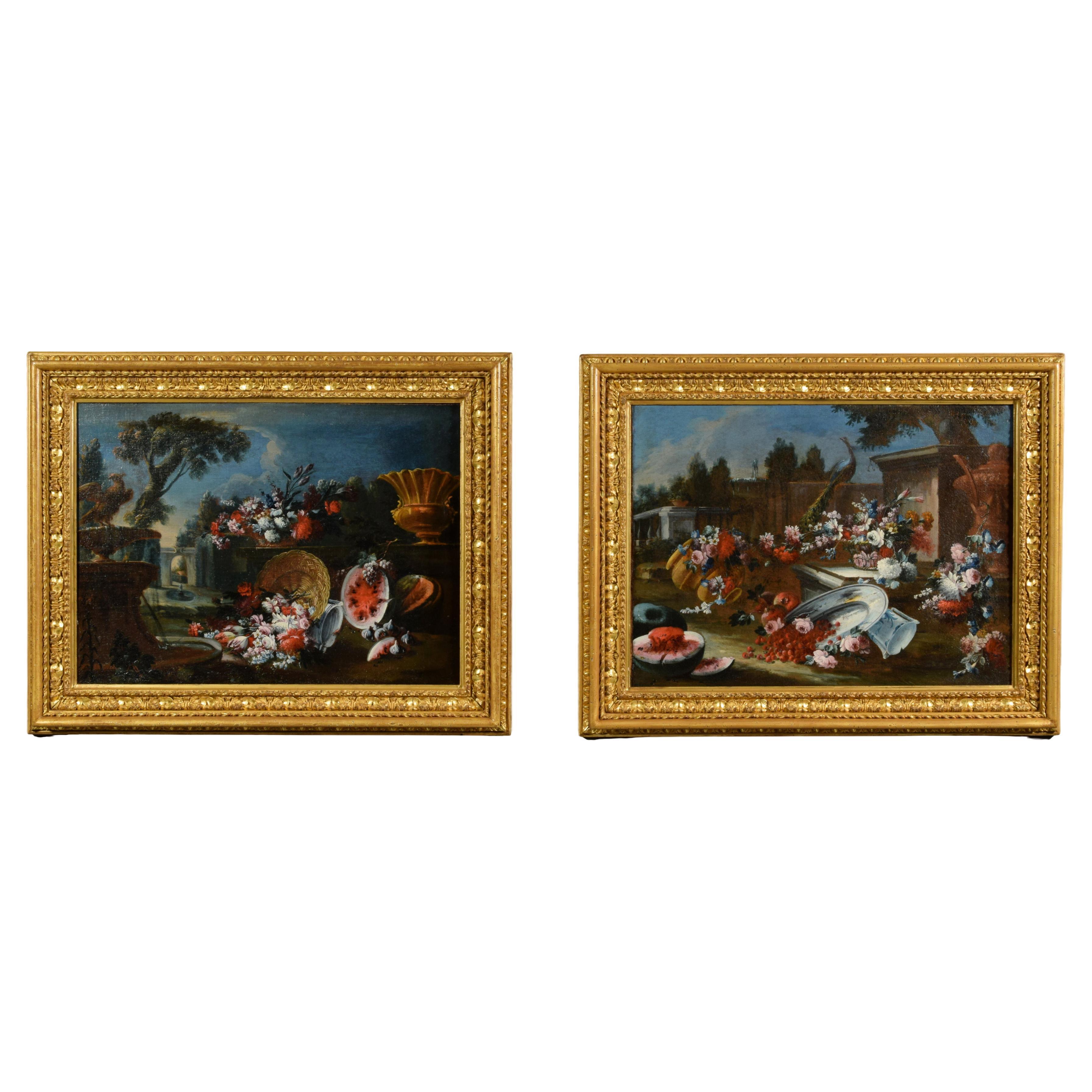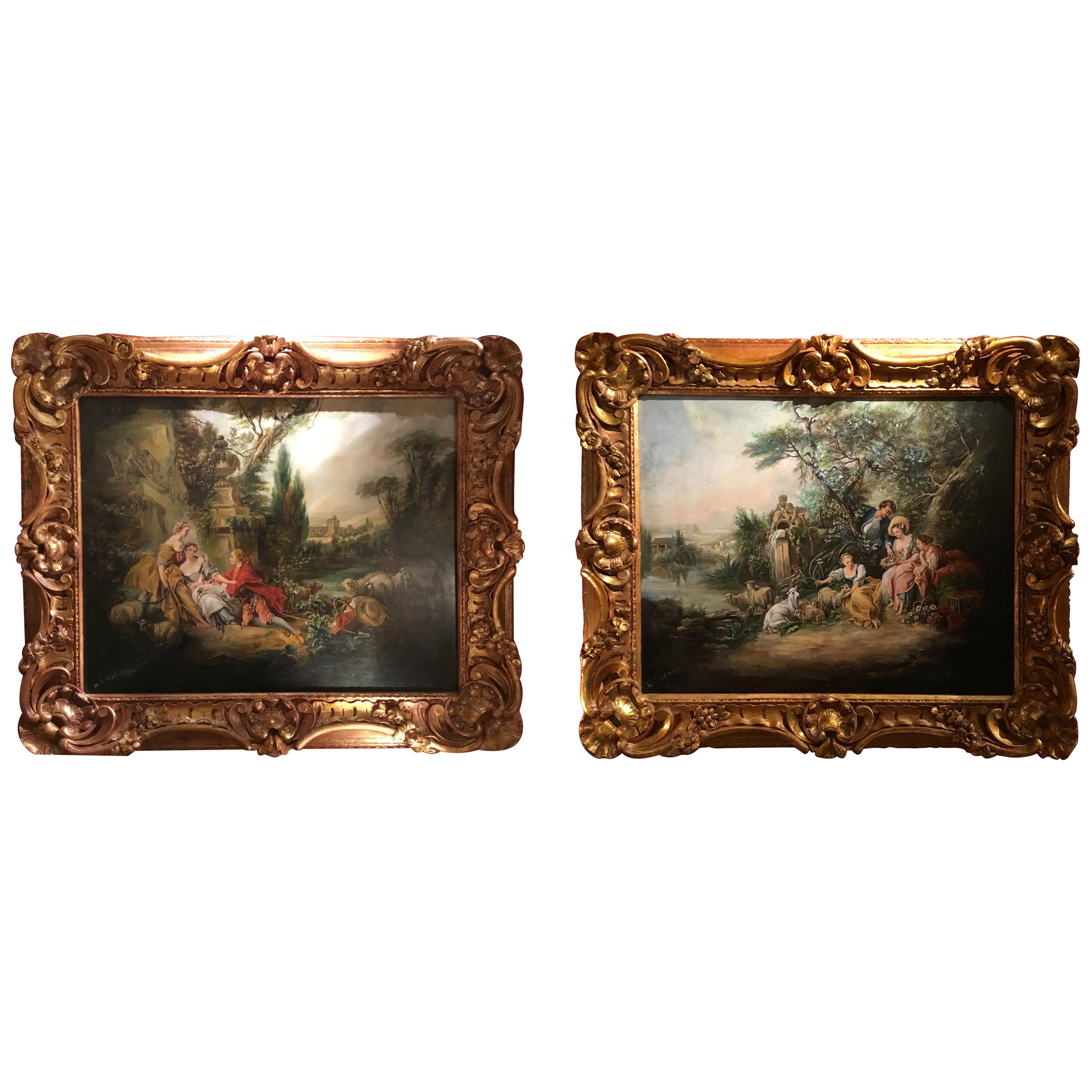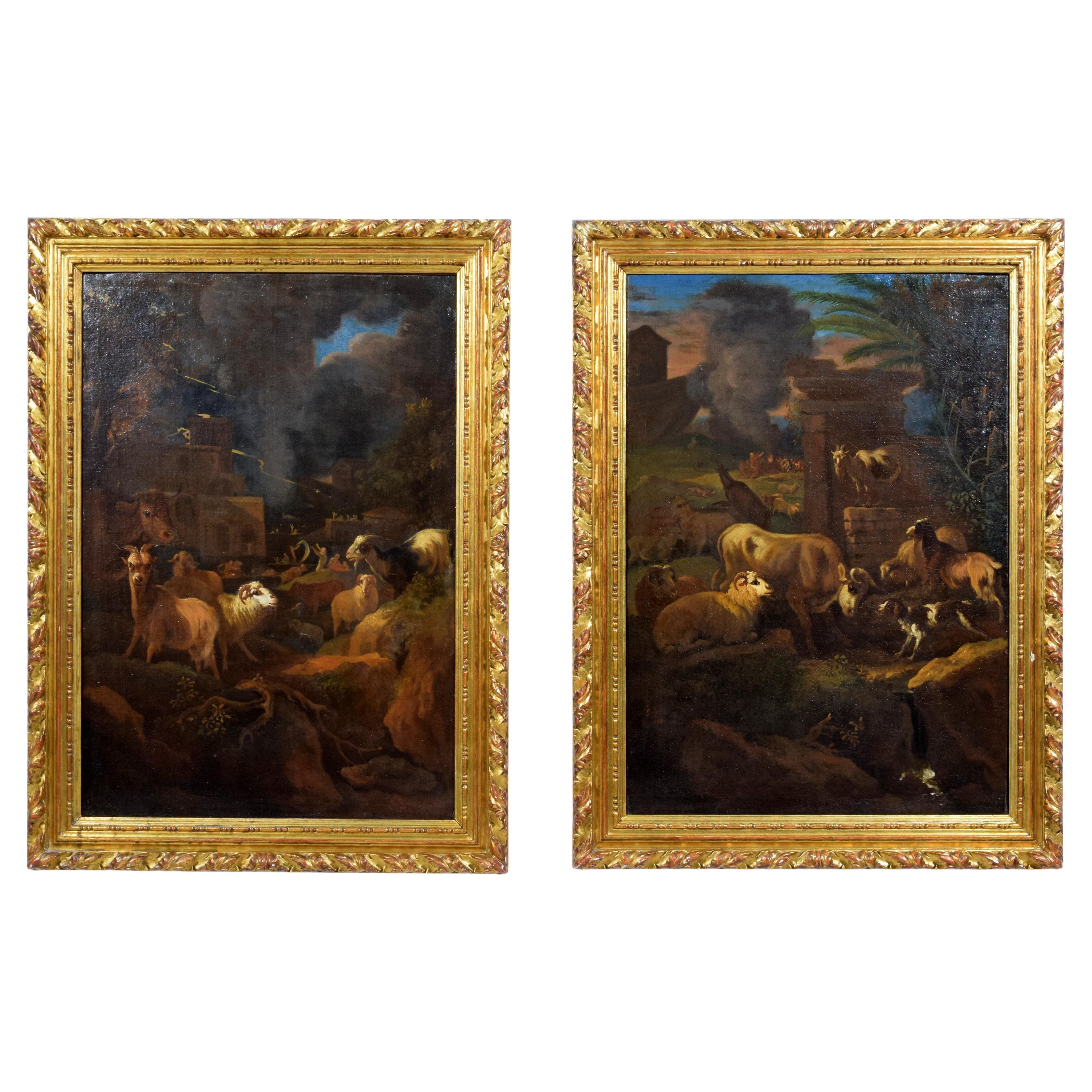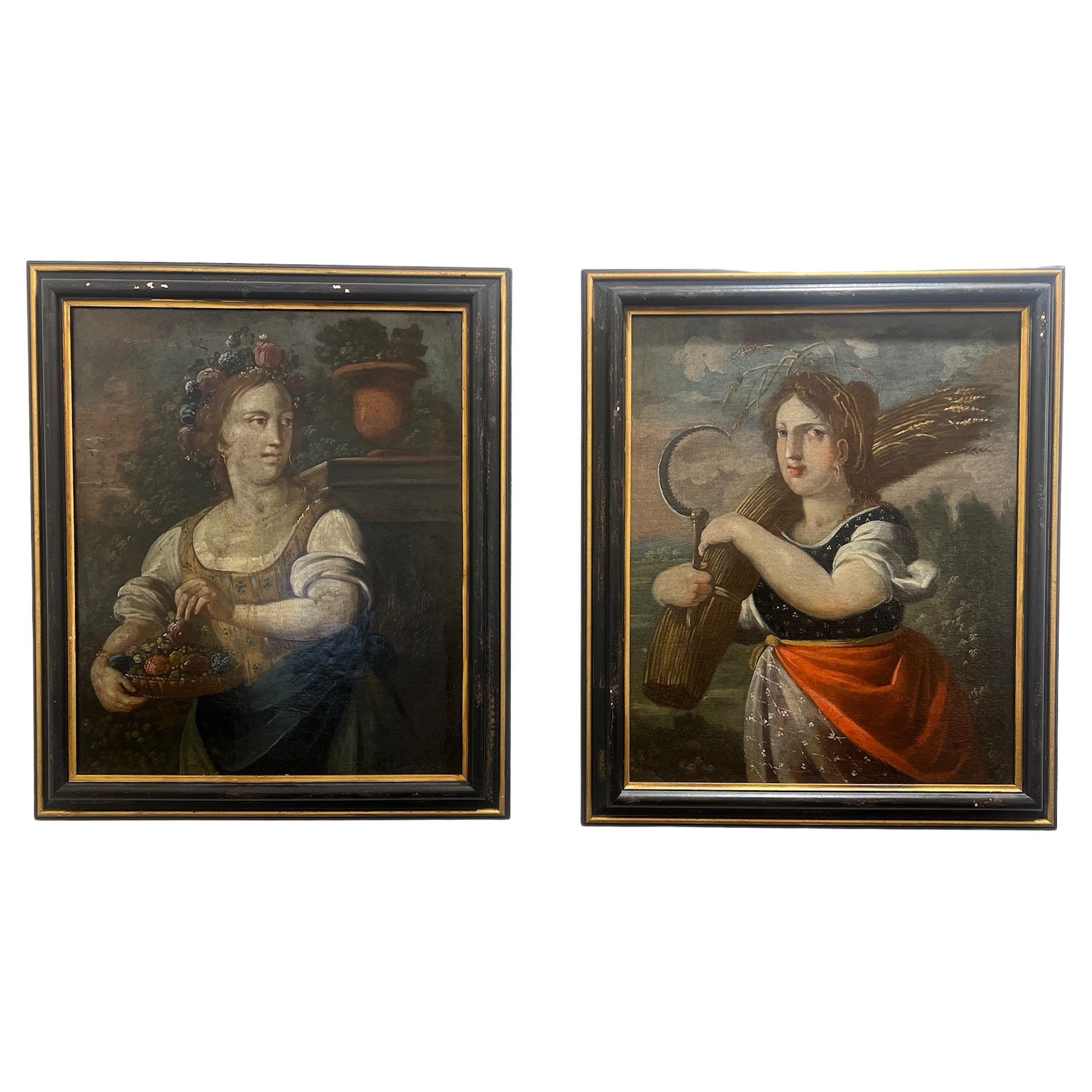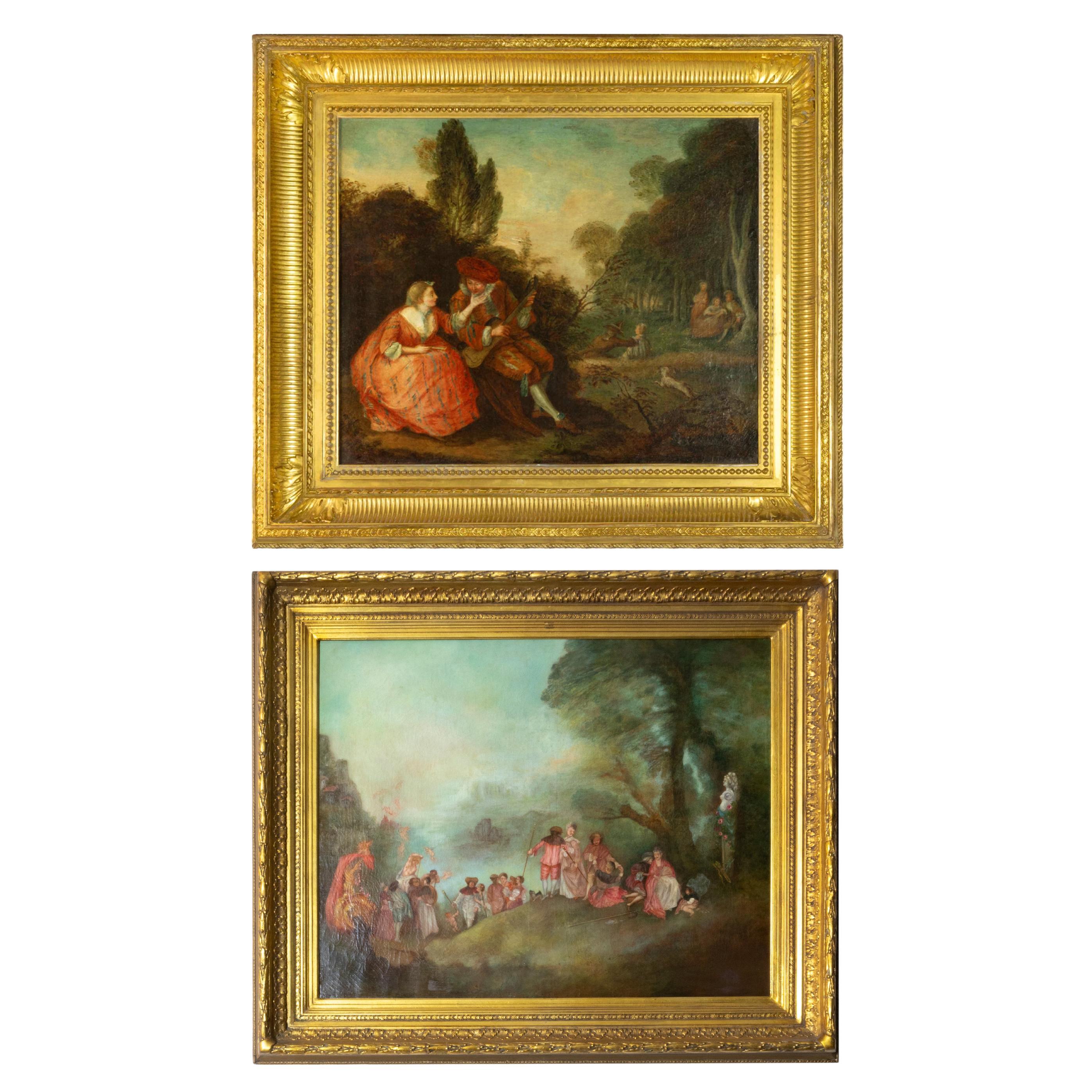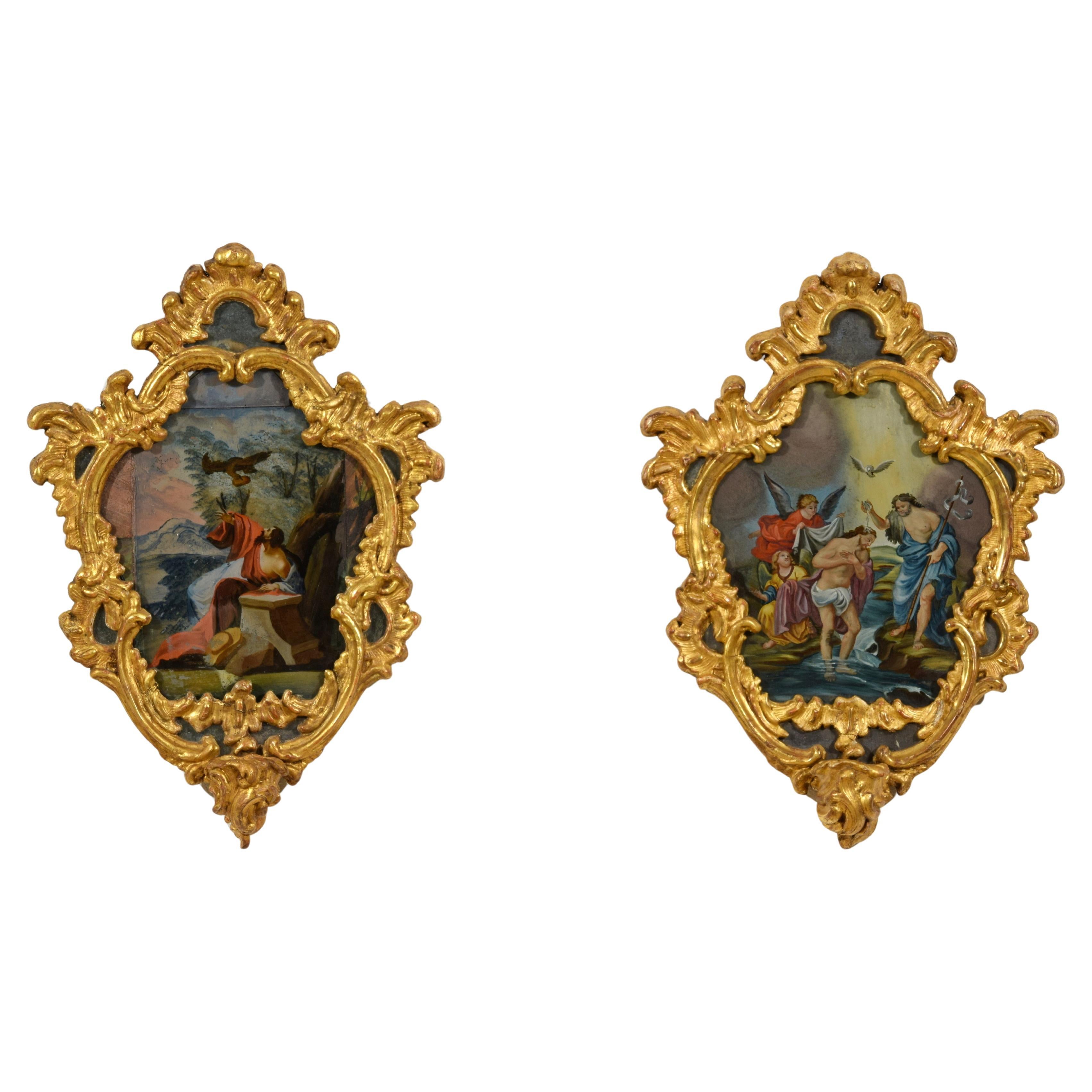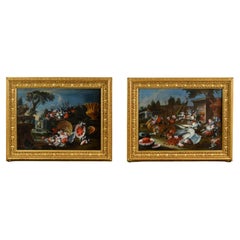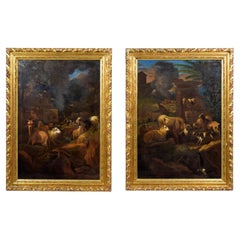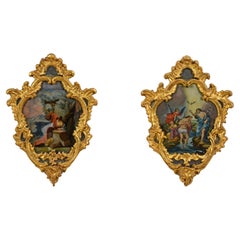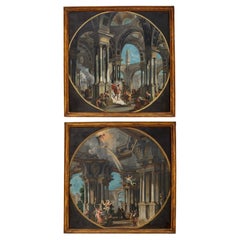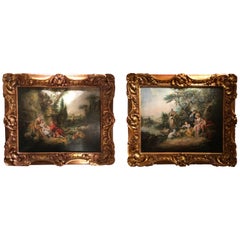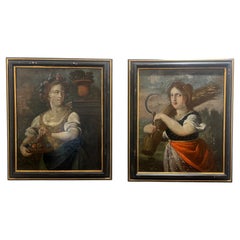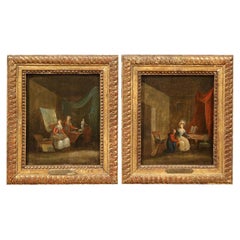Items Similar to 18Th Century, Pair of Italian Allegory Paintings By Vittorio Amedeo Rapous
Want more images or videos?
Request additional images or videos from the seller
1 of 21
18Th Century, Pair of Italian Allegory Paintings By Vittorio Amedeo Rapous
$35,421.85
$44,277.3120% Off
£26,714.55
£33,393.1920% Off
€30,400
€38,00020% Off
CA$48,973.78
CA$61,217.2320% Off
A$54,858.87
A$68,573.5920% Off
CHF 28,813.86
CHF 36,017.3320% Off
MX$667,066.28
MX$833,832.8520% Off
NOK 364,877.59
NOK 456,096.9920% Off
SEK 346,366.95
SEK 432,958.6920% Off
DKK 231,424.69
DKK 289,280.8720% Off
About the Item
18Th Century, Pair of Italian Allegorical Paintings By Vittorio Amedeo Rapous
Pair of paintings depicting the Allegory of Spring with putti and the Allegory of Autumn with putti, Vittorio Amedeo Rapos (Turin 1729-1800), 1786
The pair of valuable paintings was made in 1786 (as reported by an inscription on the back of one of the two paintings) by Vittorio Amedeo Rapos (or Raposo), one of the best active painters in Piedmont in the second half of the eighteenth century.
In the canvas presented here on the left is an allegory of spring with children playing, running with a dog and chasing hares; The work of the right represents the allegory of autumn with four putti who linger around a cart pulled by a sheep. The canvases are characterized by a precious light and a delicate and calibrated color range.
The two works can be connected with the paintings of Rapos of the years 1780-1790 made for the Royal Palace of Turin and comparable with other paintings of allegorical theme of the author kept at the Bana Intesa San Paolo in Turin, Palazzina di Caccia di Stupinigi and the Palazzina Marone Cinzano (now the headquarters of the Industrial Union of Turin). Clearly derived from French prototypes of the Louis XV era, the genre treated since ancient times and also spread among the Italian Renaissance painters in the form of bacchanalia, again willingly by painters of the seventeenth-century classicism, During the eighteenth century France experienced a growing success. The subjects proposed an innocent and at the same time mischievous vision of the relations between the sexes, and evoked the idea of an archaic and pastoral world full of grace and seduction.
The paintings were perhaps parts of a boiserie or a decorative set not yet identified (perhaps allegories of the four seasons or personifications of the twelve months of the year). Given the high quality and refined taste that pervades them, it is believed that they were created within the Turin Court or its closest entourage.
Vittorio Amedeo Rapos, painter linked to the Court of Turin, in 1747 is reported by documents as present in the celebrated school of Claudio Francesco Beaumont. Since 1752 his activity as author of cartoons for the tapestries of the Regia Manifattura Torinese has been documented; from the same year he also began a business of portraitist. In 1759 Rapos was a confrere of the Accademia di San Luca in Turin and from this time he began to paint religious altarpieces for many churches in Piedmont. Under the guidance of Beaumont, Rapos practiced all kinds of painting, including landscape, collaborating in 1757 with Vittorio Amedeo Cignaroli for the Palazzina di Stupinigi. Also for Stupinigi, he painted in 1765 all the decoration of the bedroom of the Duke of Chiablese with hunting trophies, cherubs and flowers. In the seventies the artist is now in full expansion and works for the Court, painting paintings for the castle of Moncalieri and churches. In 1778 he was appointed professor of the re-established Academy of Fine Arts in Turin and was registered with the members until his death. In the eighties his activity expanded still geographically, with works created for the Asti, the Cuneo, the Eporediese, and for the Susa Valley. In 1785 he received commissions from the Savoy and the Dukes of Aosta, as well as for many prestigious churches in Turin.
Rapos’s style is unmistakable in the rather complex panorama of the Beaumont school. The painter uses in fact very special color ranges with clear and cold shades of crystal clear transparency. With sharpness of design elaborates works crowded with characters of an elegance sometimes icy and static that already borders on neoclassicism. Strongly influenced by the art of his master, Rapos in his maturity gradually detached himself from the contemporary French painting with evident and strong influences from Boucher and Jean Marie Vien.
We apologize for any translation errors
- Creator:Vittorio Amedeo Rapous (Painter)
- Dimensions:Height: 35.83 in (91 cm)Width: 43.31 in (110 cm)Depth: 2.37 in (6 cm)
- Style:Rococo (Of the Period)
- Materials and Techniques:
- Place of Origin:
- Period:
- Date of Manufacture:1786
- Condition:Wear consistent with age and use.
- Seller Location:IT
- Reference Number:1stDibs: LU4405237079652
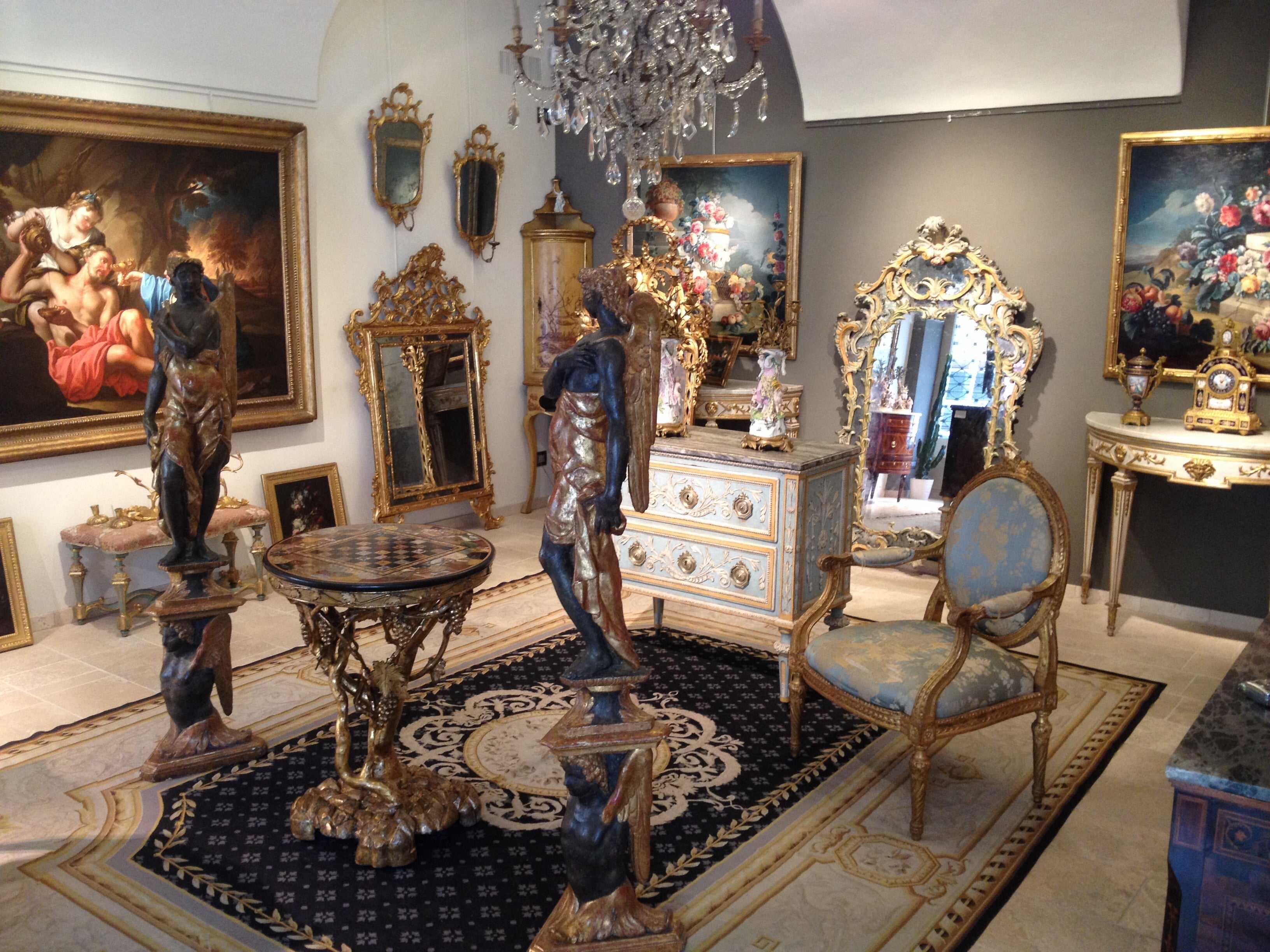
About the Seller
5.0
Platinum Seller
Premium sellers with a 4.7+ rating and 24-hour response times
Established in 1980
1stDibs seller since 2019
56 sales on 1stDibs
Typical response time: <1 hour
- ShippingRetrieving quote...Shipping from: Italy
- Return Policy
Authenticity Guarantee
In the unlikely event there’s an issue with an item’s authenticity, contact us within 1 year for a full refund. DetailsMoney-Back Guarantee
If your item is not as described, is damaged in transit, or does not arrive, contact us within 7 days for a full refund. Details24-Hour Cancellation
You have a 24-hour grace period in which to reconsider your purchase, with no questions asked.Vetted Professional Sellers
Our world-class sellers must adhere to strict standards for service and quality, maintaining the integrity of our listings.Price-Match Guarantee
If you find that a seller listed the same item for a lower price elsewhere, we’ll match it.Trusted Global Delivery
Our best-in-class carrier network provides specialized shipping options worldwide, including custom delivery.More From This Seller
View All18th Century, Pair of Italian Still Life Painting, attr. to Francesco Lavagna
By Francesco Lavagna
Located in IT
Francesco Lavagna (Italy, Naples 1684-1724)
Pair of paintings depicting Still Life composition of flowers and watermelon and garden in the background
The paintings, beautifully mad...
Category
Antique Early 18th Century Italian Baroque Paintings
Materials
Canvas
1681, Pair of Paintings signed Grechetto da Leone as Govaert G. VAN DER LEEUW
Located in IT
1681, Pair of Paintings signed Grechetto da Leone as Govaert G. VAN DER LEEUW
Oil on Canvas
Dimensions: cm W 91 x H 123 x D 6; canvas: cm W 72 x H 103.5
This pair of fine paintings,...
Category
Antique 1680s Italian Baroque Paintings
Materials
Canvas
18th Century, Italian Pair of Paintings on Glass in Giltwood Frames
Located in IT
18th Century, Italian Pair of Paintings on Glass in Giltwood Frames
This exquisite pair of paintings executed on glass is presented within finely carved and gilded wooden mirrors da...
Category
Antique Mid-18th Century Italian Rococo Paintings
Materials
Glass, Giltwood
18th century, Couple of Italian Paintings Capriccio with Mythological Scenes
Located in IT
Couple of architectural capriccio with mythological scenes, oil on canvas, painter from Bologna active in the 18th century
The two large and valuable pantings depict two architectur...
Category
Antique Early 18th Century Italian Baroque Paintings
Materials
Canvas
Couple of Italian Paintings Depicting Capricci, Francesco Aviani ‘1662-1715’
Located in IT
Francesco Aviani (Italy - Venice, 25-11-1662 / 1715) att.
Couple of paintings depicting Capricci
Oil on canvas, 135 x 183 cm, without frame
The two large and fine paintings depict two illusionistic architectural renderings, with views of colonnades and arched buildings, animated by figures. The compositions are characterized by the harmony with which the painter introduces the sumptuous architectural monuments, the mirrors of water, the buildings in the distance and the views of the landscape. Dominates with a color on the tones of brown and ochre that stands out on the blue sky, marked by some cloud of steam. The insertion of the figures to enliven the architectural views also balances with the set.
The Capriccio, an artistic genre that has made its way into Italian painting since the 17th Century, is characterized by the representation of fantastic architectures or prospective inventions, sometimes combined with elements drawn freely from reality. The two paintings are an example of this type and they are a very interesting and Fine artwork.
The remarkable pictorial quality emerges both from the composition of the ensemble and from the way in which the artist describes the views with great attention to detail, highlights and refined, perfectly realistic, chiaroscuro.
The same must be recognized for the figures: these are described with a wise brushstroke, quick and quick touches give the dynamism of the moment that is captured, as if time had stopped to show and narrate what is happening.
The painting on the right represents a large Baroque building in stone and paved with marbles, two floors, with moving façade, large columns with corinthian columns, a large portal with a staircase with large footsteps, a balustrade with string, from which some figures appear, and two equestrian monuments in bronze. The sumptuous building overlooks a large POOL of water, with a gushing fountain, around which some characters sit. In the second floor is described a white palace from which rises a tower crowned by a structure with wrought iron loggia. In addition there is a bridge and some architectural ruins behind which some mountainous reliefs fade towards the horizon.
On the staircase is described a particular scene. The people seem to be part of a very precise story. A woman, in the shadow of a parasol supported by a servant, would seem to drive out of the palace a man, who, taken under his arm by two maidens with a determined attitude, is led to a boat.
The scene could be identified with the biblical episode of the parable of the prodigal son (Luke 15,11-32), at the moment when the prodigal son is robbed and driven away by the harlots.
The episode tells of a man with two children. The youngest said to his father: “Father, give me the part of my inheritance”. And the father divided the substances. After not many days, the youngest son, collected his things, left for a far country and there he lost his substances with prostitutes and living as a debaucher. When he had spent everything, there came a great famine in that country and he began to find himself in need. Reduced to hunger, he was forced to be a pig herder to survive. He therefore meditated in his heart to go to his father and ask for his forgiveness and to be welcomed anew, even as a servant.
While still on the road, however, the father saw him and ran towards him, receiving him with open arms. He then ordered his servants to prepare a great feast for the occasion, killing for the purpose the "fatty calf". The firstborn did not understand why his brother was given such treatment, and reminded the parent that he, who had always obeyed him, had never received a single kid to celebrate with his friends. The father answered him: «Son, you are always with me and everything that is mine is yours; but it was necessary to celebrate and rejoice, because this brother of yours was dead and came back to life, was lost and was found».
The parable of the prodigal son was often portrayed in painting and the scene he finds most is certainly that of returning home in his father’s arms. Among the many is a canvas by the famous painter Giovanni Paolo Pannini (or Panini) (Italy – Piacenza, 1691– Rome, 1765) kept at the Hallsborough Gallery in London.
Rather rare, however, is the scene of the prodigal son driven and robbed by harlots. There is an engraving by Hans Collaert II (1561-1620) in which this moment is described in the background compared to the moment, narratively later, in which he is penitent among the pigs.
The second painting, certainly pendant of the first, represents a similar palace, with some characters overlooking the balustrade marcapiano and other figures around the large bathtub quadrilobata. In the foreground is described a monument with two large stone sculptures. In the distance some architectural elements and, beyond, the mountains are lost on the horizon.
The studies related to the numerous painters of architectural views and caprices, active in Italy, and the archival documents found, which could better clarify commissions, biographies and certain works, are scarce and sporadic. Therefore there are still many difficulties in reconstructing a catalogue of autograph works for each author. Through paintings in private collections, in museums and paintings passed on the antique market it is however possible to advance some attributions in order to better delineate the various artistic figures.
The style of the works studied here leads to a dating that runs between the 17th and 18th Centuries, with obvious influences dictated by the perspectives of the brothers Galli Bibiena. The analysis of the architectures and the chromatic palette suggests that we are in the presence of a northern Italian and Venetian author. Observing the decorations and the volutes, the brightness and the perspective disposition in fact, we find several analogies with those used by the Vicenza painter Francesco Aviani, excellent in pictorial perspective and architectural views.
The biographical profile of Francesco Aviani (Italy - Vicenza, 1662-1715) was essentially traced in 1956 by Andreina Ballarin, then re-visited by Federica Spadotto in 2014 and Giancarlo Sestieri in 2015. Certain documents about his life are scarce, as are the documented works.
He was born in Venice, probably on 25 November 1662, to Bernardo and a Magdalene whose surname is unknown, and was baptized on 3 December 1662. Between 1701 and 1703 he worked, together with his brother MarCo, sculptor, for the fresco decoration (now illegible) of the church villa in Soella (Vicenza). On October 16, 1703 he married Isabella Carcano. On March 26, 1715 he made a will and died on April 3 of the same year, in Vicenza.
The frescoes in the refectory of the sanctuary of Monte Berico in Vicenza are considered authentic works by Aviani, probably made in 1708; the paintings preserved in the Civic Museum of Vicenza: “Landscape with Lazzaro and the rich Epulone”; “Christ among the doctors”; “The miraculous fishing”, works not datable but with attribution corroborated by style. In addition, the frescoes in the east and west corridors of the Villa La Rotonda, near Vicenza; the fresco in the apse basin of the chapel of the church S. Croce, Vicenza, now destroyed; the frescoes of the central hall of Villa Camerini a Montruglio (1714) and a painting of a “Porto Regio”, of which we have a print engraved by Dall'Acqua.
From his works emerges the artistic background that animated the Venetian culture in the early eighteenth century. The scenic grandeur with which Aviani treats the architecture also suggests a stay in Emilia of the painter, in which he could have come into contact with the environment of the Bibiena. These contacts would be confirmed by the press of Cristoforo Dall'Acqua (Vicenza 1734-1787), “Il porto regio”, after a painting of Aviani. The press was part of a group of engravings, representing royal buildings, reproducing paintings of the Bibiena. In the eyes of Dall’Acqua, therefore, Aviani’s work was not foreign among those of the Emilians.
Inside the sumptuous architectural whims, Aviani often depicts biblical scenes, in which the characters share the space and the narrative rhythm, along with figures drawn from everyday scenes, memories of the Veronese and Bassano heritage. Also in the works covered by this study the author does not seem to want to give up a biblical subject, though the purpose of the paintings appears to be clearly a staging scenography-architectural within which the characters are relegated to the role of extras.
From the examination of the architectural Capriccio gathered under the name of Aviani then emerge common elements. The comparison between these works and the works in question highlights the proximity of the compositions. The imposing and scenic architectures are in fact equally characterized by the perspective-scenographic ability diffused in emilian “quadraturisti” and in Bibiena work. In fact, you can see the spectacular slender architecture in the lower part, the loggias that create chiaroscuro games with arches and binate columns placed on massive bases and overhung by projecting cornices.
Significant also the comparison with two paintings with architectural whims in a night vision attributed to Francesco Aviani.
In Aviani’s works it is possible to find a certain knowledge of the Roman Codazzi paint nd its early development of the eighteenth century, developed with the Locatelli, the Pannini and the less known Domenico Roberti. To Roberti have been recently attributed two works that have some compositional affinity with the canvases in question. The same can be done for a work on the antique market, attributed to Pietro Francesco...
Category
Antique Late 17th Century Italian Baroque Paintings
Materials
Canvas
18th Century, Italian Pair of Oil on Canvas Paintings by Francesco Simonini
By SIMONINI
Located in IT
Francesco Simonini (Parma, 16 June 1686 - Parma, 1766)
“The rest of the soldiers” and “The march of soldiers”
oil on canvas
cm 40 x 58 and 40 x 60 ; frame: h 52,5 x W 70,5 x D 6 an...
Category
Antique Early 18th Century Italian Baroque Paintings
Materials
Canvas
$27,265 Sale Price
35% Off
You May Also Like
Pair of French 19th Century Oil Paintings after Francois Boucher in Gilt Frames
Located in Houston, TX
Pair of exquisite paintings after Francois Boucher. Signed illegibly in lower left. The frames
Are heavily carved and gilt in a medium tone gold. Boucher was a highly
Admired artist of the 18th century. His work was very popular with the French
Aristocracy. His works were in the rococo style and captured beautiful
Garden scenes of romantic figures...
Category
Antique Mid-19th Century French Paintings
Materials
Paint
$25,200 Sale Price
30% Off
Pair of 18th Century Italian Oil Paintings
Located in Houston, TX
Pair of Italian School Paintings from the 18th Century. " Allegory of Summer and Autumn" Oils on canvas. In simplistic black frames with slight gilding.
Category
Antique 1780s Italian Paintings
Materials
Canvas, Paint
$6,950 / set
Pair Of French Baroque Oil Painting, After Jean Antoine Watteau
Located in Lisbon, PT
A pair of two very large antiqued reproduction oil painting after Antoine Watteau:
- A very large antiqued reproduction oil painting after Antoine Watteau. Features an antiqued canv...
Category
Antique 19th Century French Baroque Paintings
Materials
Canvas
$7,104 Sale Price / set
39% Off
Pair of 18th Century Paintings on Board in Gilt Frames Signed N. Lavreince
By Niklas Lavreince
Located in Dallas, TX
Set in the original carved gilt frames, these beautiful antique paintings were created in France, circa 1770. The first composition titled "...
Category
Antique Mid-18th Century French Paintings
Materials
Giltwood
Pair of 18th Century Louis XVI Watercolors in Original Giltwood Frames
Located in Dallas, TX
These antique colorful watercolors were crafted in France circa 1780, set in the original giltwood frames with glass protection, each art work depicts a courting scene with a young g...
Category
Antique Late 18th Century French Louis XVI Paintings
Materials
Glass, Giltwood, Paper
A Pair of Oil Paintings on Copper, Bolognese School, 18th Century
By Annibale Carracci
Located in ARMADALE, VIC
A Pair of Oil Paintings on Copper, Bolognese School, 18th Century
XVII century, in the style of Annibale Carracci (1560–1609), Circa 1660-1680's.
Provenance: Formerly with Cesare de...
Category
Antique 18th Century Italian Paintings
Materials
Copper
More Ways To Browse
Italian Rococo Painting
French Rococo Tapestry
Hunting Tapestry
Crystal Dog
Boucher Flower
French Hunting Tapestry
Italian 18th Century Tapestries
Italian Renaissance Tapestry
Tapestry With Cherubs
Antique Industrial Cart
Italian Boiserie
Antique Flower Cart
French Flower Cart
Four Seasons Putti
18th Century Tapestry Cartoon
Four Seasons Cherubs
Voc Plate
Walnut Hutch
